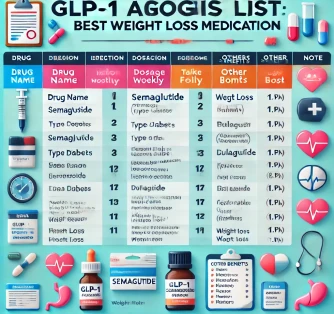Menu
Weight loss
Hormones
Sex
EXPLORE
MEET NU IMAGE MEDICAL
TREATMENTS
MEET NU IMAGE MEDICAL
TREATMENTS
MEET NU IMAGE MEDICAL
GLP-1 Agonist List: Find out how each one works


Comprehensive GLP-1 agonist list: routes, benefits, and side effects
GLP-1 receptor agonists have become a cornerstone in treating type 2 diabetes and weight management. These medications, which imitate the effects of the naturally occurring hormone GLP-1, help regulate blood sugar levels and promote weight loss. In this post, we'll provide a comprehensive list of GLP-1 medications, discussing the route of administration, benefits, and potential side effects for each.
1. Semaglutide
Semaglutide can be administered through injections or orally, offering flexibility based on patient preference. The injectable form is taken once weekly, while the oral option is taken daily. Semaglutide is known for its high effectiveness in promoting weight loss and controlling blood sugar levels. However, patients should be aware of potential side effects, including nausea, vomiting, diarrhea, and constipation. There is also a rare risk of more serious side effects, such as pancreatitis and thyroid tumors.
2. Liraglutide
Liraglutide is administered through a daily injection and is utilized for both weight loss and diabetes management. It aids users in achieving steady weight loss and improving metabolic health markers. However, patients may experience side effects such as nausea, vomiting, and diarrhea, particularly when beginning the medication. Additionally, there are potential risks, including pancreatitis and kidney problems, especially in individuals with pre-existing conditions.
3. Dulaglutide
Dulaglutide is administered as a once-weekly injection, providing a convenient option for those who prefer less frequent dosing. It offers benefits for both weight management and cardiovascular health, making it especially appealing for patients with heart concerns. However, common side effects include nausea, vomiting, and diarrhea. Additionally, there is a risk of pancreatitis and potential kidney issues, particularly in susceptible individuals.
4. Tirzepatide
Tirzepatide is administered as an injectable and is a newer GLP-1 medication that has demonstrated remarkable effectiveness in weight loss, often outperforming older GLP-1 drugs. By targeting both GLP-1 and GIP receptors, it provides enhanced metabolic benefits. However, the most common side effects are gastrointestinal, including nausea and vomiting, with additional risks such as pancreatitis and gallbladder issues.
5. Exenatide
Exenatide, administered as an injectable, was one of the first GLP-1 medications available and comes in both short-acting and long-acting forms. It supports weight loss and blood sugar control, although it may be less potent compared to newer options. Common side effects include nausea, vomiting, and diarrhea, with a rare risk of pancreatitis and potential kidney concerns.
6. Albiglutide
Albiglutide is administered as a once-weekly injection and is primarily used for managing type 2 diabetes. It offers modest weight loss benefits and is generally well-tolerated. However, users may experience gastrointestinal symptoms such as nausea and diarrhea. Like other GLP-1 agonists, there is a rare risk of pancreatitis.
7. Lixisenatide
Lixisenatide is administered as a daily injection and is primarily used for controlling blood sugar levels in individuals with type 2 diabetes. It also provides some weight loss benefits, especially when used in combination with other treatments. Common side effects include nausea and vomiting, and there is a risk of hypoglycemia when used alongside other diabetes medications.
Conclusion
GLP-1 agonists offer a range of options for those managing type 2 diabetes and obesity. Each medication comes with its unique benefits, routes of administration, and potential side effects. Understanding these differences is key to selecting the most suitable treatment for your needs. Always consult with a healthcare provider to determine which GLP-1 medication is right for you.
Ready to explore your options further?
Visit Nu Image Medical to learn more about how GLP-1 medications can support weight loss and health goals.
This article is for informational purposes only and does not constitute medical advice. The information contained herein is not a substitute for and should never be relied upon for professional medical advice. Always talk to your physician about the risks and benefits of any treatment. Nu Image Medical may not offer the medications or services mentioned in this article.
